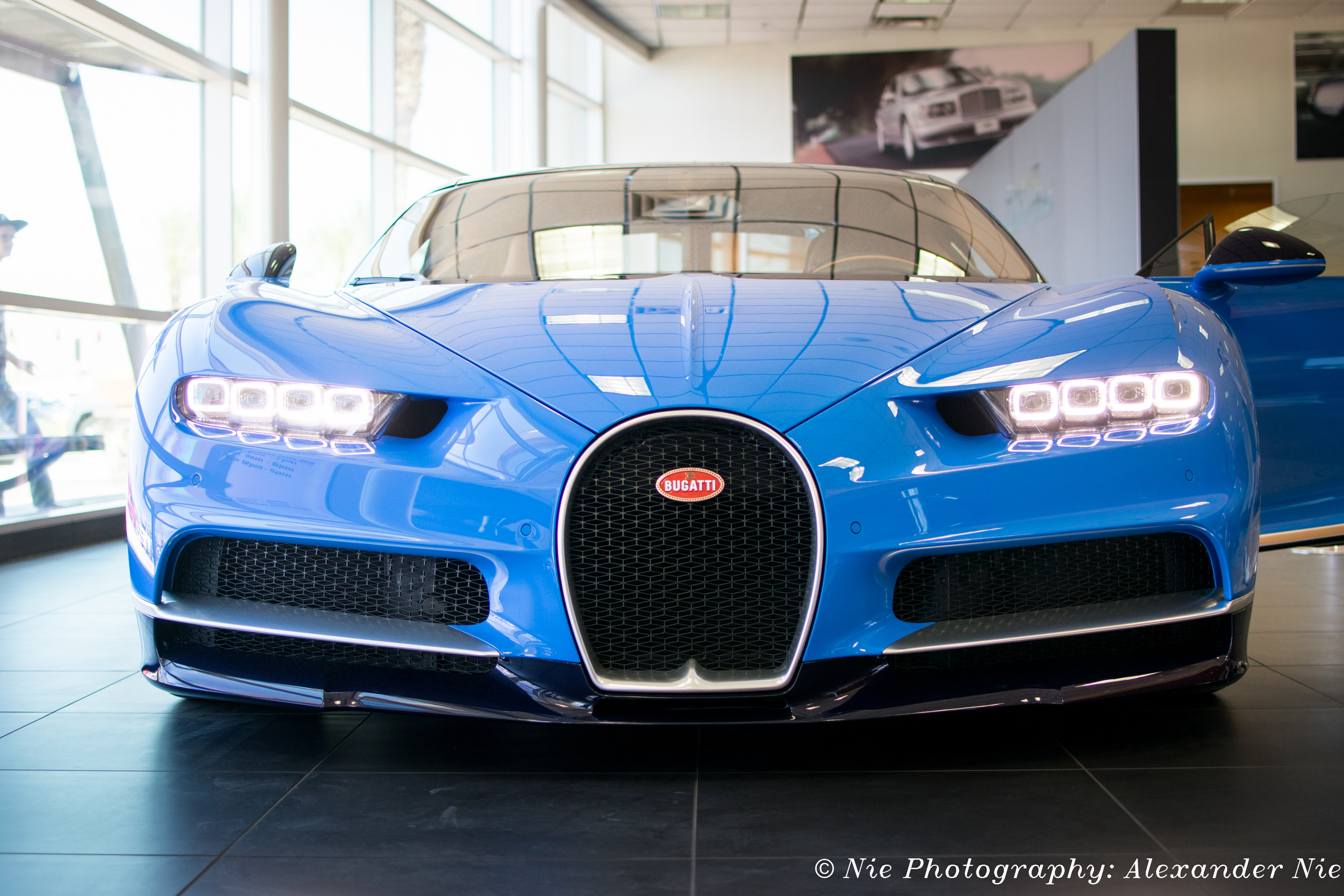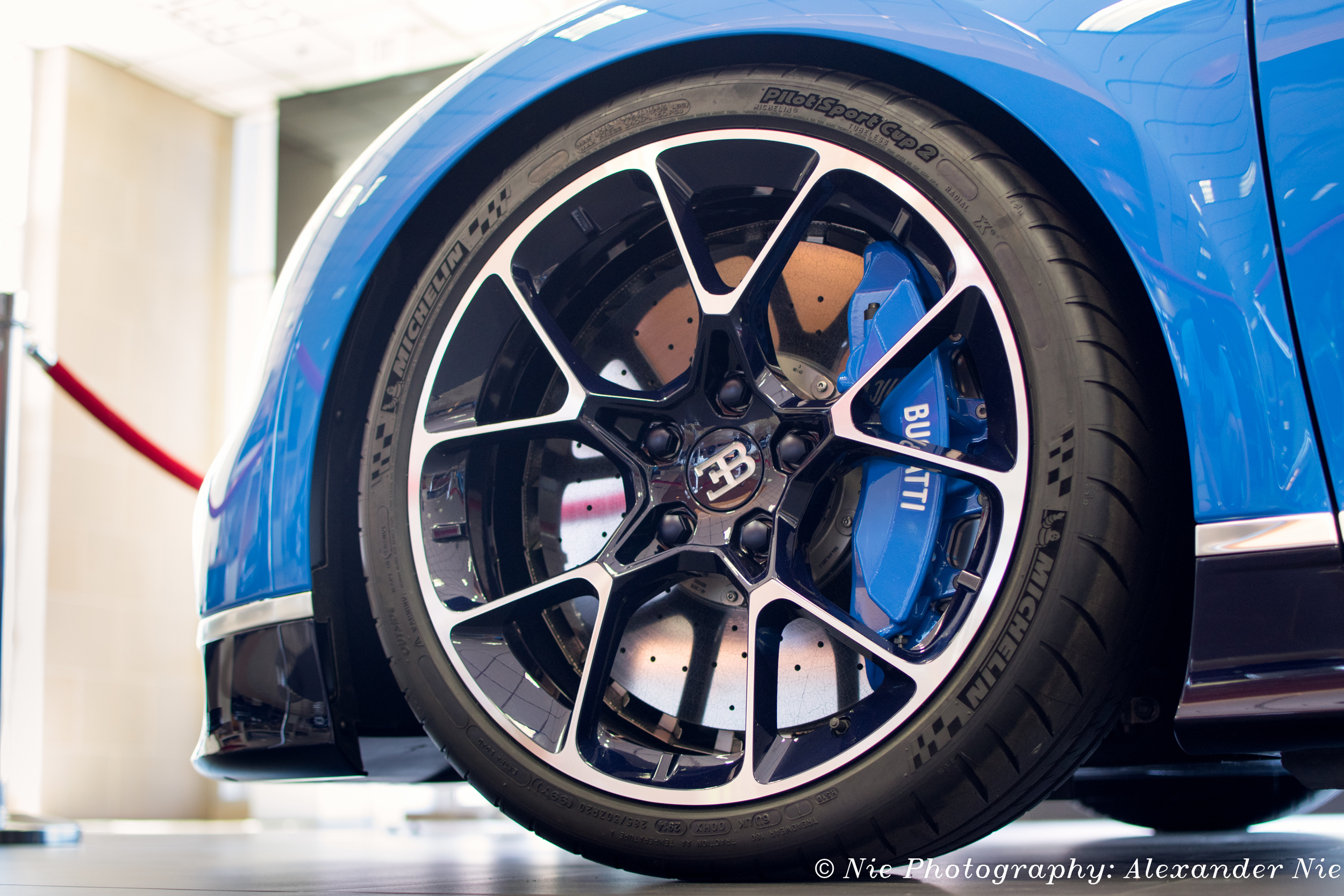Living in Arizona has its perks, especially as a car person. Scottsdale is home to all kinds of amazing cars and car events, all of which I had no idea existed three years ago. The wonder never ends, as I would have never guessed that I would be able to come face-to-face with the Bugatti Chiron, fresh from Geneva and resting before Pebble Beach.







To the uninformed, the 2017 Bugatti Chiron is the successor of the Bugatti Veyron, the poster-car for "fast car" since its release in 2005. How do you top a 1000+hp, 250+mph, $1,500,000 USD hypercar? Take everything that was excessive and turn it up to 11.
A quick-run down of the specs. The Chiron will cost you $2.6 million dollars, if you somehow get your hands on one of the already-sold-out-500 copies to be produced. The engine now pumps out 1500 horsepower and 1200 lb-ft of torque from a revised quad-turboed W16 engine, venting all of those burned dinosaurs through six exhaust pipes, four out the rear and two out the underside of the car, creating a blown diffuser, the same technology that was banned in Formula One. In a world where the "Holy Trinity" have turned to creating hybrid hypercars, Bugatti stuck with time-old-tradition and kept the car with a gasoline engine only, using sheer force of engineering, displacement, and boost to crank out the power. With all of that power, it seems a little disappointing that the top speed is only 261 mph. However, this isn't it's final form. The 261mph top speed is "limited", since its record-setting top-speed attempt will attempt to crack 270mph.
There will be no shortage of options, either, to make sure each car is unique. After all, if you're paying for the price of six Lamborghini Aventadors, you want to make sure that the Cars and Coffee meet you roll up to doesn't have a Chiron with the same grill-color, a $6,800 option. This is a steal compared to the bare carbon fiber option, which is $289,000, enough to buy a McLaren 650S with $24,000 left over. Or, if you aren't feeling up to completely exposed carbon fiber, a partly exposed carbon engine cover is a mere $17,000, which is perfect since this is the same price as the sports seats, so you can go even faster. Or, tl;dr, everything is expensive, but luckily, there is a four-year service plan that will cover all maintenance on the car, making it more affordable!
There's no need to go on about big the numbers on this car is, because they're massive. Rather, lets talk about the design of the car. Now, this is completely objective, but when there is so much press over all the numbers I just quoted, personal opinion is always interesting to hear. I know many people who think the Chiron looks ugly, but I disagree. The Veyron was nice looking, but, dare I say it, it was a little "bland", since it was mostly made of basic, round shapes. As an engineer, I appreciate the engineering beauty of the Veyron, but I felt the aesthetic beauty was a bit lacking. The Chiron, however, is completely different. There are aggressive character lines all over the car, giving it the aggressive, assertive look it needs to say "Hey, you wanna race? Cuz you'll lose" to the face of P1s and LaFerraris, the current definitions of hypercars. The long taillight, and the angular rear that juts out, housing red taillights with beautiful geometry inside, is a sight to behold that no picture can do justice to. It captures the imagination as it looks like an impulse engine that belongs on the Enterprise in Star Trek rather than a car that sits in front of me. The massiveness of the wing on the back lets you picture the air rushing past it when the Chiron is racing at full speed. Those LED DRLs on the front of the car give an unmistakable, angry look, befitting for the rest of the front fascia. And the width, my God this car is so wide, it looks like it will not hesitate to eat small children and compact cars for breakfast. As an engineer, I love all of the vents and scoops, as it affirms my belief that form follows function, that engineering is beautiful, that engineering can be an artistic masterpiece. To think of how much air and fuel the engine eats at full-throttle, how the air moves around the body at Vmax, and how everything inside the car manages to not spontaneously combust is a beautiful thought in my head.
But the one obvious styling detail that i absolutely love is the characteristic 'C' line throughout the car. It's present on the side, acting as the dividing line between the two-tone color scheme. It splits the car in half, forming a crease on the hood that becomes pronounced on the roof and becomes a bridge overlooking the engine. The seats of the interior are bisected by a 'C', swooping gracefully through the cabin. In a world where extreme design is the norm, the Chiron nails it with unique styling elements that will make it to the walls of five-year olds and thirty-five year olds everywhere.





Will the Chiron be able to define this generation of hypercars like its predecessor did, especially with fiercer competition in the guise of the Koenigsegg Agera R/ One:1/Regera, Porsche 918 Spyder, McLaren P1, and Ferrari LaFerrari? Only time will tell.
Am I fanboying over this car? Possibly. But when it's a car designed to define a generation like its predecessor did, it's hard not to be overwhelmed and infatuated at first-sight. Or second sight. Or third. The Veyron was an engineering marvel. The Chiron is this plus a work of art. It'll be great to keep this rosy image of the car in my head, as it is highly likely this will be the only time in a long, long while I will ever see this car. But, I hesitate to say "ever". After all, this is Scottsdale. Who knows what will show up next?




















































